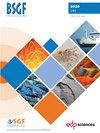用地层模拟验证狮子湾边缘裂谷后演化
IF 2.6
3区 地球科学
Q2 GEOSCIENCES, MULTIDISCIPLINARY
引用次数: 9
摘要
盆地和被动边缘的沉积结构是由沉降、沉降和沉积物供应等参数的复杂相互作用决定的。本文基于对沉积古标志物的地层学研究,利用反射地震数据的大型三维网格、与现有钻探数据的相关性以及折射数据,提出了狮子湾(西地中海)裂谷后(20 Ma-0 Ma)垂向运动的定量分析。通过直接使用三维分析的沉积几何形状来测量裂谷后的沉降,并通过数值地层模拟进行验证。在陆架和陆坡上,沉降对应于不同幅度的向海倾斜,而深盆地则是纯粹的垂直沉降。研究表明,这些构造域与以往地球物理资料所强调的深部地壳构造域相吻合,并且破碎后的沉降遵循裂陷期的初始铰线。对每个层段的每个域的沉降速率进行了量化。在距离旋转铰线一定距离的情况下,上第四纪陆架整体沉降速率是恒定的。相反,中新世的沉降速率在东西陆架上差别很大。同时进行了以墨西尼亚盐度危机(MSC)为中心的地层模拟。他们的结果与我们的裂谷后沉降估计一起讨论,以便为未来中新世沉降的详细量化提供想法和假设,包括与MSC相关的均衡调整。本文章由计算机程序翻译,如有差异,请以英文原文为准。
Post-rift evolution of the Gulf of Lion margin tested by stratigraphic modelling
The sedimentary architecture of basins and passive margins is determined by a complex interaction of parameters, including subsidence, eustasy, and sediment supply. A quantification of the post-rift (20 Ma-0 Ma) vertical movements of the Gulf of Lion (West Mediterranean) is proposed here based on the stratigraphic study of sedimentary paleomarkers using a large 3D grid of reflection seismic data, correlations with existing drillings, and refraction data. Post-rift subsidence was measured by the direct use of sedimentary geometries analysed in 3D and validated by numerical stratigraphic modelling. Three domains of subsidence were found: on the continental shelf and slope, subsidence corresponds to a seaward tilting with different amplitudes, whereas the deep basin subsides purely vertically. We show that these domains fit with the deeper crustal domains highlighted by previous geophysical data, and that post-break-up subsidence follows the initial hinge lines of the rifting phase. Subsidence rates are quantified on each domain for each stratigraphic interval. At a constant distance from the rotational hinge line, the Plio-Quaternary subsidence rate is constant on the shelf overall. Conversely, Miocene subsidence rates are very different on the eastern and western shelves. Stratigraphic simulations focused on the Messinian salinity crisis (MSC) were also performed. Their results are discussed together with our post-rift subsidence estimates in order to provide ideas and hypotheses for future detailed quantifications of Miocene subsidence, including isostatic readjustments linked to the MSC.
求助全文
通过发布文献求助,成功后即可免费获取论文全文。
去求助
来源期刊
CiteScore
5.80
自引率
0.00%
发文量
18
审稿时长
>12 weeks
期刊介绍:
BSGF - Earth Sciences Bulletin publie plusieurs types de contributions :
1. des articles originaux, couvrant tous les champs disciplinaires des Géosciences, à vocation fondamentale mais également à vocation plus appliquée (risques, ressources);
2. des articles de synthèse, faisant le point sur les avancées dans un domaine spécifique des Géosciences, qu''elles soient méthodologiques ou régionales ;
3. des monographies sur la géologie d’une région donnée, assorties d’informations supplémentaires, cartes, coupes, logs, profils sismiques … publiées en ligne en annexe de l’article ;
4. des articles courts de type « express letter » ;
5. des livrets-guides d’excursion (qui suivront le même processus d’examen éditorial que les articles plus classiques) ;
6. des comptes rendus de campagnes à la mer ;
7. des articles de données géodésiques, géophysiques ou géochimiques, pouvant devenir des articles de référence pouvant conduire à des interprétations ultérieures.
BSGF - Earth Sciences Bulletin constitue également un forum pour les discussions entre spécialistes des Sciences de la Terre, de type comment-reply ou autre. Tous les articles publiés, quelle que soit leur forme, seront accessibles sans frais (articles en Open Access) sur le site de la SGF et sur celui de Geosciences World dans la mesure où les auteurs se seront acquittés d’une contribution de (Article Processing Charges – APC) de 300€ pour les membres de la SGF et 500€ pour les non-membres.

 求助内容:
求助内容: 应助结果提醒方式:
应助结果提醒方式:


